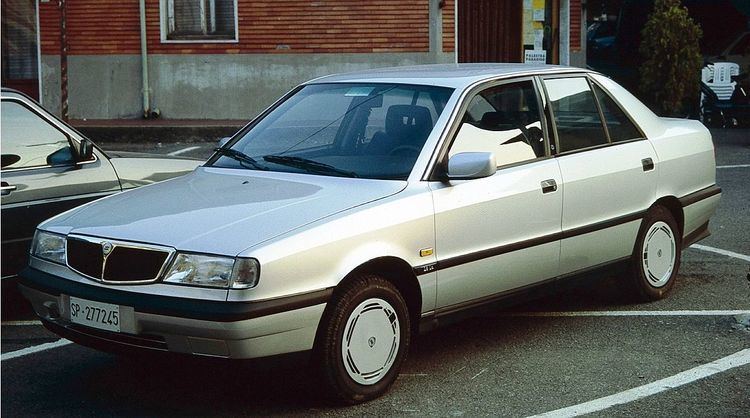Class Large family car (D) | ||
 | ||
Production 1989–2000418,084 built Body style 4-door saloon5-door station wagon | ||
The Lancia Dedra (Type 835) is a compact executive car produced by the Italian automaker Lancia from 1989 to 2000. It was initially designed to support, and later to replace, the Prisma that, six years after its launch, was having difficulties to keep in pace with its latest opponents. It can be considered as the saloon version of the second generation Delta, that was launched four years later, in 1993.
Contents
History
The task of the Dedra was demanding: it must gather the legacy of Prisma, which relaunched the Lancia brand in the field of compact executive cars, and expand its market share if possible. Larger than its predecessor, the Dedra was presented as the second flagship car of Lancia, as a car that could satisfy those looking for an elegant medium-sized sedan but did not want to buy an executive car, as the Thema.
The design, by Ercole Spada of the I.DE.A Institute, produced an excellent drag coefficient of only 0.29. The core of the product was prestige, exclusivity, personality and comfort, achieved through a high level of equipment and use of materials (e.g. Alcantara) as well as details such as special paints, alloy wheels and an attention to soundproofing, ventilation and other issues. Inside the ability to obtain the perfect driving position was helped by the adjustable seats, steering wheel and electrically adjustable mirrors. Safety, both passive with a structure designed to minimize injury in an accident, and active, such as ABS and airbag, was also near the top of the Dedra's agenda.
It was based on the Fiat Tipo-floorpan, because the idea of Fiat Group at the end of the 80s was to achieve, from a single floorpan (for reasons of economies of scale), four different cars from the same base: good value for money for the Fiat Tipo (1988), elegance for Lancia Dedra 1989, convenience at a competitive price for the Fiat Tempra (1990) (with its large boot) and sportsmanship for the Alfa Romeo 155 (1992). Also were designed on the same floorpan the Lancia Delta and the Fiat Coupe.
In 1991 was launched the Dedra Integrale. It used the same engine and transmission that the Delta Integrale 8v. The Delta Integrale 8v engine is one of the world's most competition proven power units, a 2-litre 4-cylinder fuel injected twin cam engine, fitted with contra-rotating balancing shafts, and a Garrett T3 turbocharger and associated inter-cooler to aid volumetric efficiency that boost power output to 171 PS (127 kW) in catalyzed version. The Dedra Integrale also uses the same permanent 4-wheel drive of the Delta Integrale, and includes the new Visco Drive 2000 traction control system. Also includes the electronically controlled suspension available as option in the 2.0 and upper versions.
When the Dedra was launched, it was a good time for Lancia: The Thema had been facelifted a year earlier, and despite being on the market for five years was selling well, the Delta (1979), thanks its continued success in competition was living a second youth, and the Y10 had a slight restyling and good sales. However, the Dedra was not a strong success outside Italy. A major facelift in 1993 did little to boost the car's sales success and the whole Lancia range including the Dedra was withdrawn from RHD markets a year later. The car, after 1993 also sold as a station wagon, remained popular on the Italian market until it was replaced by the all-new Lybra at the end of the 90s.
A total of 418,084 Dedras were manufactured during its commercial life.
Summary
Versions
The Dedra had some revisions. The first was in 1992, to adapt the engine, resizing the features and introducing the HF Integrale 180 HP version. The second was between 1994 and 1998, with the introduction of the DOHC 16V engine.
First manufacturation (1992)
The Dedra 2.0 Turbo 8V HF Integrale, with equip LX, had a digital panel and also had an autoblocante, allowing to control the car better in dangerous surfaces. This car, thanks to the 180 HP engine, reached a speed limit of 230 km/h, with 13 L/100 km. The Dedra HF Integrale, and Turbo, could have an optional rear wing spoiler to give a better aerodynamic at high speeds. The price was 25.822,88 €.
The Dedra 2.0 Turbo 8V HF FWD was lighter than Integrale, but even a bit lower than Integrale. Both of them had wheels 195/50 R 15.
Second manufacturation (1994) (restyling)
3 years later, the HF versiones were replaced by atmosferic 16V engines.
Tercera tirada (1996 - 1998)
Engines
Reception
In October 2013, Top Gear magazine placed the Dedra on its list of "The 13 worst cars of the last 20 years."
